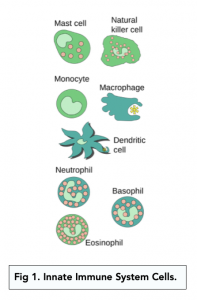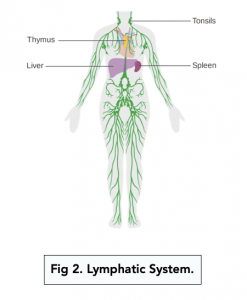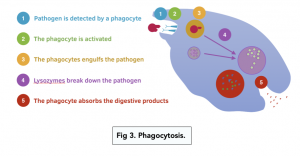The Innate Immune Response (A-level Biology)
The Innate Immune Response
Innate Immune Cells
- Cells of the innate immune system can be found everywhere. Cells of the innate immune system can be found in many areas including the exposed areas of the body near mucous membranes, as well as deep inside tissues.

- Immune cells are often found in the lymphatic system. Cells of the innate immune system can also travel the body via complex transport system known as the lymphatic system which has vessels that extend throughout most of the body.

Neutrophils and Macrophages
- Neutrophils are found in blood and tissue fluid.
-
- Neutrophils are the more common phagocyte out of the two
- Neutrophils are made in the bone marrow, and reside in blood and tissue fluid.
- Neutrophils are short-acting and initiate the immediate response.
-
- Macrophages are found in blood and lymph nodes.
-
- Macrophages are bigger than neutrophils.
- Macrophages develop in lymph nodes, and are made in bone marrow.
- Macrophages are involved in the adaptive, specific immune response.
-
Steps of Phagocytosis
Phagocytosis means “cell eating”. In phagocytosis, cells can engulf pathogens or cells and internalise them.
- Pathogen is detected by a phagocyte. Pathogens have unique antigens called Pathogen Associated Molecular Patterns (PAMPs). Phagocytes can recognise these PAMPs through specialised receptors on their cell surface membranes known as Pathogen Recognition Receptors (PRRs).
- The phagocyte is activated. When the PRRs recognise and bind to a PAMP, it activates the phagocyte. Signalling molecules such as interferons may also help in phagocyte activation.
- The pathogen may be coated in opsonins. Opsonins refers to molecules which coat the pathogen so that phagocytes can easily bind to and phagocytose the pathogen. Examples of opsonins include antibodies, complement proteins, and other small circulating proteins.
- The phagocytes engulfs the pathogen. The phagocyte grows cytoplasmic extensions to engulf the pathogen, and internalises it into its cytoplasm. The pathogen is engulfed in a vesicle known as the phagosome. The mechanism for phagocytosis is the same as the mechanism for endocytosis discussed in the previous chapter.
- Lysozymes break down the pathogen. Inside the phagocyte, the phagosome fuses with a lysosome. Upon fusion, the lysosome releases lysozymes into the phagosome which then hydrolyse the pathogen.
- The phagocyte absorbs the digestive products. The hydrolysis products, such as broken-down proteins, are then absorbed by the phagocyte:
-
- Some products are routinely discarded from the phagocytes via exocytosis as waste.
-
- Some products are loaded into MHC class II molecules and used in the antigen presentation process to activate T-helper cells.

Finding the Pathogen
Before step 1, how does the phagocyte find the pathogen? There are two methods:
- Antibodies attract phagocytes. Antibodies produced by the body can recognise and bind to pathogens. These antibodies act as a chemical beacon which attracts phagocytes to the pathogen.
- Chemicals attract phagocytes. The pathogen releases chemicals, which attract pathogens to the site.
Both processes are examples of chemotaxis.
The innate immune response is the first line of defense against pathogens and is a nonspecific response that occurs immediately after a pathogen enters the body.
The innate immune response works by recognizing and removing pathogens through physical and chemical means. This includes physical barriers such as skin and mucous membranes, and chemical mechanisms such as the release of antimicrobial substances and fever.
The components of the innate immune response include physical barriers such as skin and mucous membranes, and chemical mechanisms such as the release of antimicrobial substances, inflammation, and fever.
Skin acts as a physical barrier to pathogens, preventing them from entering the body. It is also covered in antimicrobial substances that help to kill pathogens on contact.
Mucous membranes line the body’s openings and serve as a physical barrier to pathogens. They also contain antimicrobial substances that help to kill pathogens before they enter the body.
Inflammation is a chemical process that occurs in response to a pathogen and helps to remove it from the body. It involves the activation of immune cells, the release of chemical signals, and the increase of blood flow to the infected area.
Fever is a rise in body temperature that occurs in response to a pathogen. The elevated temperature helps to kill pathogens and reduce their ability to reproduce.
Antimicrobial substances are chemical compounds produced by the body that help to kill pathogens. These include substances such as lysozyme, which breaks down bacterial cell walls, and hydrogen peroxide, which destroys pathogens through oxidation.
The innate immune response is a nonspecific response that occurs immediately after a pathogen enters the body, while the adaptive immune response is a specific response that takes a few days to develop and is tailored to the specific pathogen. The innate immune response provides a rapid response to pathogens, while the adaptive immune response provides long-term protection.






Still got a question? Leave a comment
Leave a comment